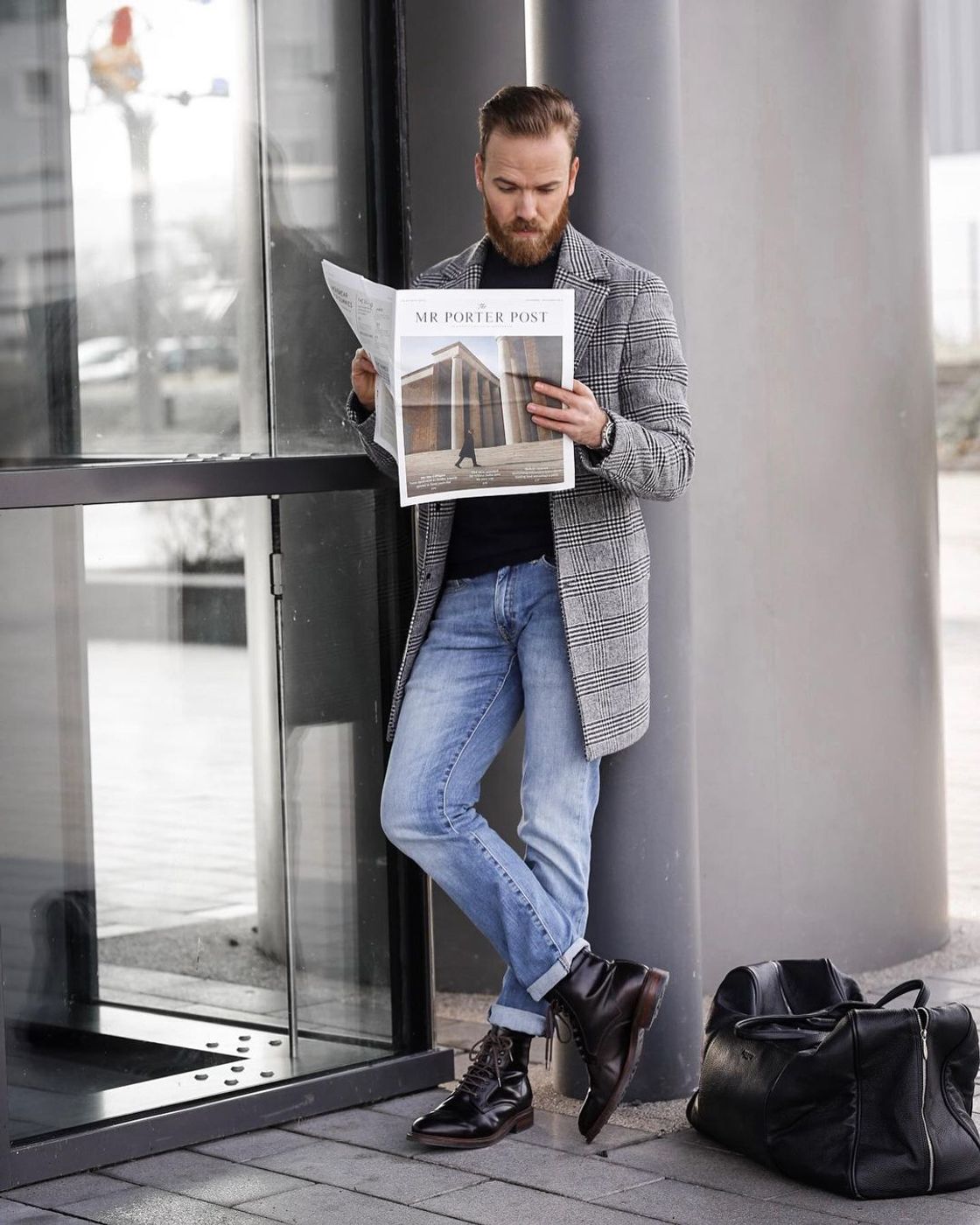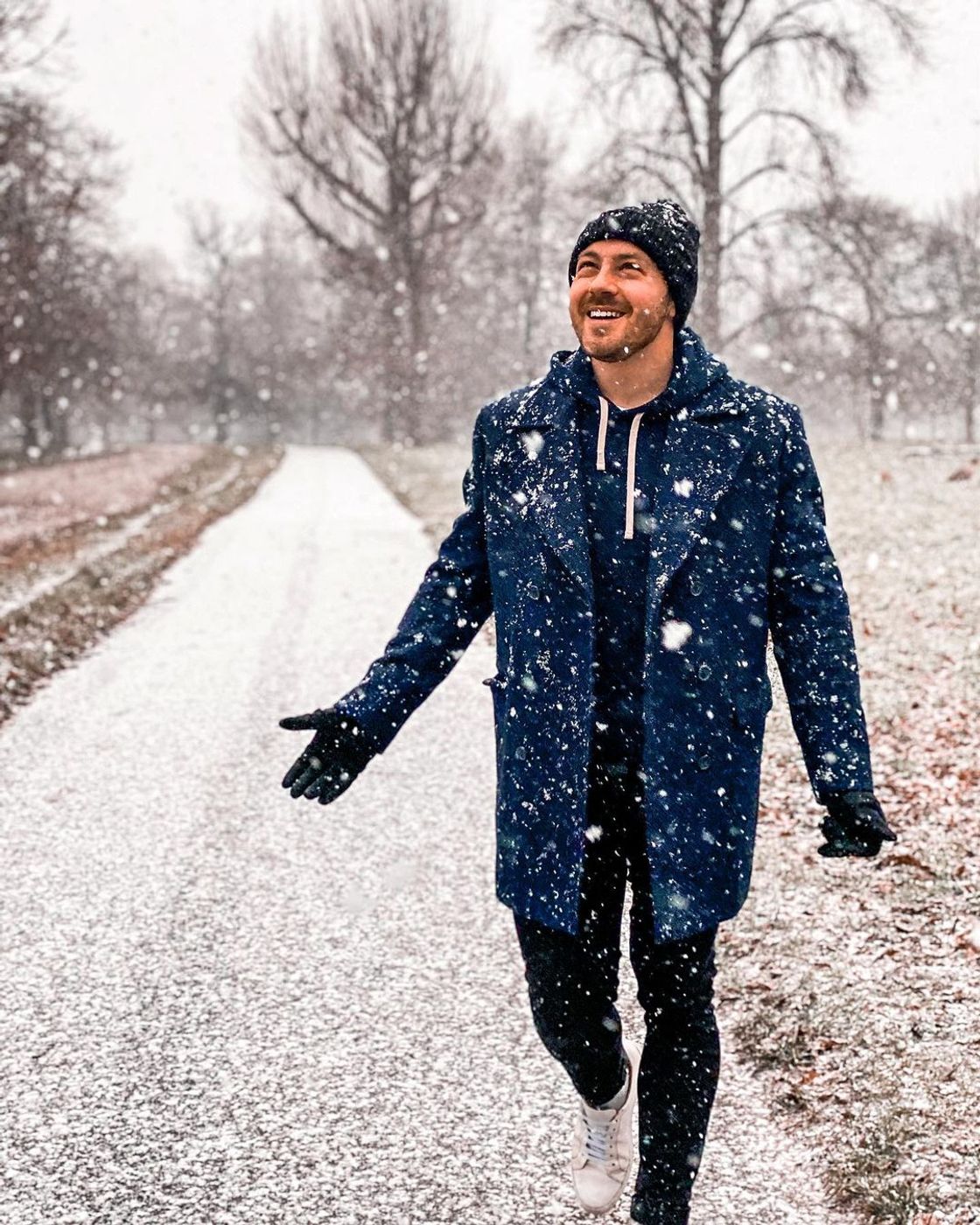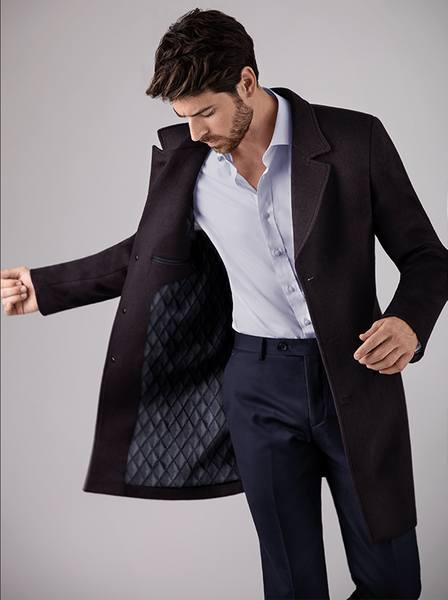Real customer @berndhower
An overcoat is a must-have in every men's wardrobe. If you want to stay warm and stylish during cold winter days, it is essential to have a carefully selected coat collection at home. Be prepared for cold, snowy, windy but also for sunny and warm days in fall, winter and spring. With this guide, we want to highlight the must-have coats, when to wear them and where to buy them. You will be a real coat expert after reading this blog.
Have you ever heard of quilted or unlined coats? Every coat has lining options to make it either a perfect winter jacket or an overcoat for warmer days. You can read more about it in this article.
So let’s start with a list of coats which are in fashion:
1. The Topcoat vs Overcoat
What is a Topcoat ?
A topcoat is a conventional staple of men’s outerwear. It is usually made of wool and has a long, sleek silhouette. The topcoat was originally made to be worn over a suit but can also be combined with a more casual look. You can even dress it down with a pair of jeans for the ultimate street-savvy style. Topcoats are lighter than overcoats.
The overcoat, made out of wool, is a long-sleeved outdoor coat that keeps you warm on cold winter days. Different variations of an overcoat will highlight your personal style. Choose between single or double breasted and the length of the coat. Let your coat sit just at your knee or extend it below your knee. It is up to you. Find more examples of custom made overcoats here.

If you need something to wear over your suit for the next event, we will suggest a topcoat. If you only get from the car to the location, without spending too much time outside, a topcoat will be the right choice for you. Have you thought about an unlined coat? This could also be an option for you. But if you need a coat which looks elegant, thinner but still keeps you warm, an overcoat is the right coat for you. Read more about coats to wear over suits here.
2. The Pea Coat vs Trench Coat
What is a Pea Coat ?
The peacoat is a very popular outerwear piece that also passes for a great winter outfit. It has a nicely tailored double-breasted [single breasted also available] styling and classic-contemporary charm. It is a very versatile outfit that can be worn with everything from a suit to sneakers. The peacoat has the innate ability to smarten up a casual look or make a formal outfit significantly trendy.
But what is the difference between pea coats and trench coats? While pea coats are made of wool, trench coats can be found made of cotton gabardine. But there are also trench coats available made of wool nowadays. So the main difference between pea coats and trench coats is not only the fabric, it's the cut and the style. Pea coats have a shorter cut to allow movement easily. Trench coats are belted coats with a longer cut. The material is thinner compared to a pea coat material. If you're interested in learning more about trench coats, check out our blog post on when to wear trench coats.

If you are looking for a coat which keeps you warm and gives your look an elegant touch we will suggest you a pea coat. Pea coats are perfect for cold winter days. The wool fabric will give you everything you need on snowy and windy days
(trench coats are more for warmer days in spring or fall). Read more about pea coats in our pea coat guide.
3. The Duffle Coat vs Pea Coat
What is a Duffle Coat?
So let’s sum up everything we know about Pea Coats. Pea Coats are warm coats made of wool with a shorter cut to give you flexibility in your movement. And the best thing: they are thicker than trench coats, so they keep you warm on very cold winter days. But what is the difference between pea coats and duffle coats?
It’s the material. Duffle coats are not only made out of wool, the fabric which names the coat, is duffel, a coarse, thick, woolen material. Combined with the characteristic hood and toggle buttons, a duffle coat is a timeless highlight in your wardrobe. A Duffle Coat is keeping you the warmest in winter.

A duffle coat is the right choice if you are looking for a coat that definitely keeps you warm on very cold winter days. The combination of the material, the hood and the cut of a duffle coat make the coat to your favorite piece on snowy and cold days. Add quilted lining to your duffle coat to stay extra warm (read more about it further in this article).
But what coat do you need in winter?
Real customer @dailytouchofclass
The coat to wear to stay warm - Temperature below 5° C
You want to stay warm even when the temperature drops under 5° C? Here is our carefully selected collection of pea coats that not only keep you warm but also look super stylish:
As already mentioned, the pea coat is made of wool. The material you need during winter days. Find more wool pea coats examples online.

Add lining to your pea coat. The quilted option keeps you even warmer. Read more about it further in the article.
The Coat to wear to stay super warm - Temperature below 0° C
It is freezing cold outside and you need to look elegant and formal? Then how about a duffle coat? The material of a duffle coat is specifically made to keep bodies warm. Combined with a hood, your neck and shouders are even more protected.

Have you ever thought about coat lining? Especially for colder days we suggest quilted coats. Keep your coat as stylish as it is but add some extra lining. No one will notice besides you and the quilted lining coat will keep you even warmer. Be prepared for temperatures below 0° C.
The coat to wear to stay cosy and stylish - Temperature above 5° C
Even though sunny and warm winter days are rare, sometimes we are lucky and the weather forecast surprises us. But what should we wear on those days? It is definitely too warm to wear a 100% wool coat without sweating.
If it is warm enough, you can wear your outfit with a overcoat. The long cut keeps you warmer than just a jacket. Add a scarf to your coat and you will look both stylish and well prepared.

But what should you wear if the temperature is higher than usual, plus staying warm is not the priority anymore? How about an unlined coat. In this way, your coat will be lighter and thinner and you can wear it on sunny winter days without sweating.
Where can you buy a winter coat?
The shops are full of winter coats. You can get your coat in every color, fabric and cut. But are you still looking for your favourite coat this winter? You can stop searching. The most important part while buying a coat is to choose the material. The choice of your fabric tells you how long the coat will last. Besides that, the fabric also decides if the coat will keep you warm enough. So in conclusion, buying a coat online is the best way to find your new trendy coat for this winter. You can use our filters to find the right coat. And to answer this question, yes, coats can also be customized and handmade according to your measurements. In this way, you can not only choose the coat which fits your personal style the most, but you can also choose the fabric, the cut and the color of your new winter item. Even if you are looking for something special, like a quilted or unlined coat, you will find it in our online shop. Here is the collection of our winter coats.
Quilted vs. Unlined Coats
Quilted Coats
Finally, we know everything about the must-have coats for men. But we have not talked about padded or unpadded coats yet. So, imagine, you find the right pea coat for yourself, but you are worried that the pea coat will not keep you warm enough this winter. Do not worry about it. By adding the right lining to your coat, a pea coat will be the right choice for you. Quilted coats, also known as padded coats are coats with an extra layer inside the coat. In this way, you do not need to decide between a stylish or functional coat, both will be combined in one outerwear. And the best thing, no one will notice. Only you, who survives the winter in this warm coat.
Do you really need a quilted coat? Here is a list of characteristics of quilted coats:
- Perfect for colder temperatures
- Adds more insulation and keeps your body warm and comfortable
- Appears and feels more structured
- More suitable for formal events thanks to its (more) structured appearance
- Prolongs the life of the garment
- A smooth lining allows a coat to slip over other clothing easily
- Padded linings drastically increase the warmth, with a very light addition of weight.
- More suitable for garments with a straight silhouette

A quilted coat is the right choice for you, if you still need a coat on freezing cold winter days. If the temperature drops below 3°C, a coat with a quilted or padded lining will definitely keep you warm. Find your favourite winter coat online and add quilted lining to your winter coat.
Unlined Coats
But there is also the option of removing the lining of a coat, so the outer and inner fabric are the same. An unlined coat, or also known as unstructured coat, is lighter and thinner than a regular lined coat. An unlined coat will be the right option for you if you are looking for an overcoat that you can wear over your outfit, but does not need to keep you warm.
Here is a list of characteristics of unlined coats:
- In warmer weather conditions
- Add more ventilation and allow your skin to breath
- Curtail excessive sweating and overheating
- Does not involve stacking layers of materials
- Are considered to be more lightweight and flexible
- Are recommended during informal events, because are less structured
- The interior manufacturing is a piece of art, because it must be very neatly finished relative to its covered counterpart
- Can be particularly welcome on heavier cloths such as tweed, making them more like three-season garments

Wear an unlined coat on warmer fall and spring days, or even on sunny winter days during the day. Even when you are looking for a coat to wear on colder summer nights, an unlined coat is the right choice for you. Find unlined coats in our online shop. Design your favourite coat and remove the lining.



















